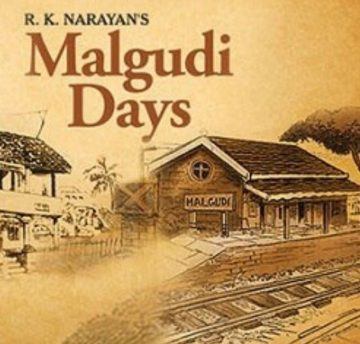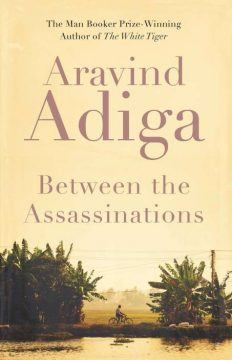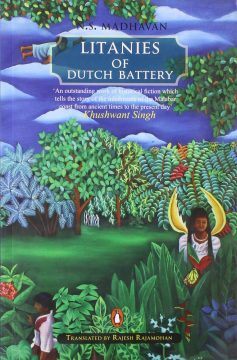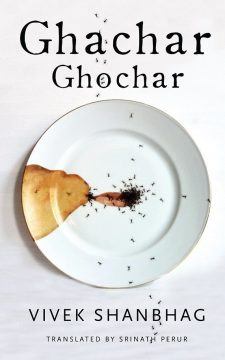by Pranab Bardhan
 A British friend of mine once told me that when he feels stressed he often turns to re-reading R.K. Narayan’s stories about Malgudi, the fictional placid small town in south India. Much earlier, in the 1930’s, a fellow-Britisher, the writer Graham Greene, had discovered Narayan and became his life-long friend, mentor, agent for the wider literary world, and even occasional proof-reader. He found a kind of ‘sadness and beauty’ in Narayan’s simple depiction of the idiosyncrasies and disappointments of ordinary lives which he imbues with a touching sense of gentle irony and compassion.
A British friend of mine once told me that when he feels stressed he often turns to re-reading R.K. Narayan’s stories about Malgudi, the fictional placid small town in south India. Much earlier, in the 1930’s, a fellow-Britisher, the writer Graham Greene, had discovered Narayan and became his life-long friend, mentor, agent for the wider literary world, and even occasional proof-reader. He found a kind of ‘sadness and beauty’ in Narayan’s simple depiction of the idiosyncrasies and disappointments of ordinary lives which he imbues with a touching sense of gentle irony and compassion.
Over the last few decades the small town has been at the center of much of urbanizing India, but the depictions in fiction today of the lives there are, as expected, much more complex in their teeming conflicts and raw agony. The literature on this even in south India is quite large, but from my own limited readings, I shall select for discussion here only three books from the last two decades, two of them translated from their originals in Malayalam and Kannada, and the third written in English.
 I shall start with the third, titled Between the Assassinations by Aravind Adiga, which is probably the furthest of the three in terms of dissonance from the life in Malgudi. Here we can definitely say: Toto, we are not in Malgudi anymore. The assassinations referred to are those of Indira Gandhi in 1984 and of her son, Rajiv Gandhi, in 1991, but in the book except for merely as a time-marker of those 7 years, they do not play any direct role. Adiga came to be widely noted after he won the Booker Prize for his short novel The White Tiger, a book of stridently raging fury at the crushing inequalities and depravity arising from India’s roaring economic growth and somewhat cardboard characters through which they are played out, a book I did not particularly like. Adiga wrote Between the Assassinations earlier but published it after The White Tiger. Here the fury is less strident, there is more nuance and variety in the characters, and along with aching sympathy there is all-enveloping hopelessness. Here is a typical scene: a lowly cart-rickshaw puller, straining hard going uphill with a heavy load, exhausted by the heat and humiliation and a painful neck, stops his cart in the middle of the busy road, shakes his fist in a futile gesture at the passing, honking traffic and shouts: ‘Don’t you see something is wrong with this world?’
I shall start with the third, titled Between the Assassinations by Aravind Adiga, which is probably the furthest of the three in terms of dissonance from the life in Malgudi. Here we can definitely say: Toto, we are not in Malgudi anymore. The assassinations referred to are those of Indira Gandhi in 1984 and of her son, Rajiv Gandhi, in 1991, but in the book except for merely as a time-marker of those 7 years, they do not play any direct role. Adiga came to be widely noted after he won the Booker Prize for his short novel The White Tiger, a book of stridently raging fury at the crushing inequalities and depravity arising from India’s roaring economic growth and somewhat cardboard characters through which they are played out, a book I did not particularly like. Adiga wrote Between the Assassinations earlier but published it after The White Tiger. Here the fury is less strident, there is more nuance and variety in the characters, and along with aching sympathy there is all-enveloping hopelessness. Here is a typical scene: a lowly cart-rickshaw puller, straining hard going uphill with a heavy load, exhausted by the heat and humiliation and a painful neck, stops his cart in the middle of the busy road, shakes his fist in a futile gesture at the passing, honking traffic and shouts: ‘Don’t you see something is wrong with this world?’
Adiga’s book of interlinked stories is about a fictional town, Kittur, on the west coast of Karnataka, an ethnically diverse town, simmering with class, communal and caste tension. They form a mosaic of conflicts and corruption, casual violence and alienation, portrayed in the ironic background of the cheerful prose of a travel guide for the town. In particular the life of the poor is an “instalment plan for troubles and horrors”, and as one character says, “there is no one coming to release us from the jail we have locked ourselves in”.
Adiga studies each of the unremarkable lives with remarkable precision.
There is the story of Ziauddin, one of “those lean lonely men with vivid eyes who haunt every train station in India”, but while resigned to be mistreated by everybody he clings to his pride that he is a Pathan (“we don’t do hanky-panky”), and when almost enticed to do some hanky-panky by a well-treating fair-skinned stranger, he finally runs away.
There is Ramkrishna “Xerox”, who has been arrested 21 times for selling illegally photo-copied books to students, and whose legs are recently broken by the police when he unwittingly sells the banned book Satanic Verses, and he takes all this as part of life, at least a step up from that of his father who used to clean toilets in the houses of rich landlords.
There is Kamath the newspaper columnist, who in attempting to write the ‘true history’ of the town discovers that the local mafia manipulates the instigation of communal riots to cover their land grabs, and that the richest man in the town kills someone in a car accident and asks an employee to take the blame, and this sticks as the police and the judge were bribed. Kamath, whom others in the newspaper office consider insane, roams the town, thinking: “It is a false earth I am walking on. An innocent man is behind bars, and a guilty man walks free. Everyone knows that this is so and no one has the courage to change it.”
There is Murali, a member of the divided communist party, who falls in love with a young country girl, whose poor family he helps to get a government welfare grant, and the widowed mother of the girl now thinks her family condition has improved enough to be able a get a better groom for her daughter than Murali.
There are many other unforgettable cases in the book, including Ratnakara Shetty, the fake sexologist, finally having a qualm of conscience; Soumya and Raju, the beggar children on a long day’s journey to another part of town to buy smack for their addicted construction-worker father; Keshava, the migrant village boy who aspires to become a bus-conductor but is waylaid by a local thug; Shankara, a young schoolboy, who is half-Brahmin and half-a backward caste, considered an outsider by both castes, expresses his grudge by detonating a home-made bomb in his chemistry class, thereby angering a teacher who shouts, “you, puckers!”—as he cannot separate his ‘f’s’ from his ‘p’s’; Jayamma, the Brahmin spinster, hating her work of taking care of spoiled children of the rich and trapped in her faith in the caste system, seeking comfort in DDT fumes; Abbasi, the shirt-factory owner, who is benevolent toward his hard-working female employees, but struggles to deal with corrupt government officials who regularly descend on him and ponders that while everyone curses the all-pervading corruption, no one has “found a way to slay the demon without giving up his share of the loot of corruption” ; and George D’Souza, who, slowly moving up in jobs first as a mosquito-repellent sprayer, then a gardener, and then a chauffeur for rich young Mrs. Gomes finally oversteps a boundary and slides back to his lowly life.
*
 The second book, Litanies of Dutch Battery, is a translation of a novel by N.S. Madhavan, a major writer of Malayalam fiction. This is about a fictional island in the Kochi backwaters of Kerala, named Lantham Bathery in Malayalam (referring to the 5 canons installed by the Dutch in its promontory in the 17th century), currently without a bridge to the mainland, and thus disconnected at night after the last ferry departs. The book depicts a sweeping panorama of life in this town, of history, mythology, public memory, personal drama and eccentricities, failures and redemptions, and ‘stories brought by the sea and winds’. It is a tapestry of rich and colorful tales of Malabar coast’s history of interaction with the Arab and western traders and conquerors (particularly the Portuguese and the Dutch, and different denominations of their religious missions), of accounts of past battles fought on its shores blended in with their legacies and the small political battles of today.
The second book, Litanies of Dutch Battery, is a translation of a novel by N.S. Madhavan, a major writer of Malayalam fiction. This is about a fictional island in the Kochi backwaters of Kerala, named Lantham Bathery in Malayalam (referring to the 5 canons installed by the Dutch in its promontory in the 17th century), currently without a bridge to the mainland, and thus disconnected at night after the last ferry departs. The book depicts a sweeping panorama of life in this town, of history, mythology, public memory, personal drama and eccentricities, failures and redemptions, and ‘stories brought by the sea and winds’. It is a tapestry of rich and colorful tales of Malabar coast’s history of interaction with the Arab and western traders and conquerors (particularly the Portuguese and the Dutch, and different denominations of their religious missions), of accounts of past battles fought on its shores blended in with their legacies and the small political battles of today.
The narrative is told by a young feisty independent-thinking dark chubby Catholic girl, Jessica, and she starts addressing us from when she was still in her mother’s womb. She comes from a carpenter family with a long tradition of boat-building (her great-grandfather stole the calculus of shipbuilding from his master, Cornelius), and the religious history of their community goes back to the 16th century when the Portuguese converted many low-caste Hindus into Christianity. Her uncle who is a famous cook (who had learnt the art of cooking biriyani from his father, who in turn had learnt it from a carpet-seller from Shiraz), says that in terms of culinary heritage people at the Malabar coast struck a better bargain when the Portuguese explorer Vasco da Gama who was the first European to come to India by sea, landed in Calicut in 1498 (he died in nearby Kochi in 1524 on his third voyage): da Gama came here mainly for pepper, which was not of much use in the daily dishes of the local people, but the latter gained a great deal from the onion and chilli that da Gama brought to them.
Halfway through the novel one day her grandfather suddenly appears, after many years of being assumed to be lost at sea in a capsized boat, now wearing a suit and bow-tie and with a white cane, blind and old but sharp in mind and overflowing memory, extra-sensitive in his hearing (in the family workshop for boat-building he’d often walk in and direct the workers to keep changing wedges till he can approve “the rhythm of sawing timber”). He takes a special liking for Jessica.
Early in the novel the island residents are preparing themselves, while imbibing copious amounts of toddy, to stage Karalman Chavittunatakam, an operatic play about emperor Charlemagne of Europe in the Early Middle Ages. All through the novel life of the townsfolk revolves around plays, cinema, religious festivals and feasts and the songs of K.L.Saigal, the famous north-Indian singer-actor of the immediate pre-Independence period.
In the description of these lives there are marvelous episodes of intervention like that of a very determined female smallpox vaccinator, Saradamma, whose arrival in the island by boat sends the residents to run for hiding places, or there is this description, in passing, of the introduction of chewing gum in the island: “Wilfred was the first merchant to introduce chewing gum in Lantham Bathery. In the silence that ensued during the prolonged act of mastication, kids of Lantham Bathery learned to think.”
Then there is the politics. You meet Comrade Ramachandra Shenoy proselytizing for the cause of the Communist Party, following a long tradition of religious missionaries in the town. (There is even an appearance of the legendary communist leader A.K.Gopalan, who is believed to have the power to make “people communist through his intense gaze”). There are whole episodes of political turmoil when the Catholic Church carries out the anti-communist “Liberation Struggle” against the first communist Government in Kerala of 1957-59, with the chief minister E.M.S. Namboodripad portrayed as the “anti-Christ of the 20th century”.
During a rice shortage in 1958 Namboodripad had encouraged people in Kerala to eat macaroni. Lawrence Pallath, Jessica’s Sunday-school teacher, in his long tirade in class against the communists brought this up: “What is macaroni? It is another form of wheat flour. Daughters and sons of Kerala would never eat wheat, even if they have to starve to death”. During a brief pause Jessica queried, “What about the holy bread?” This landed her in trouble.
While politics keeps brewing in the room in Malaca House where the local communists meet, in the next room sits a young mathematics teacher, Pushpangadan, who spends all his time there, day in and day out, trying to prove Fermat’s Last Theorem wrong. But in a temporary lapse and indiscretion (in which Jessica is, passively, involved) his reputation is sullied and on a Christmas Eve he takes his life in the river water. His suicide note written to his mother is a clear, rational explanation of his self-willed death. The note is found by the police on his table “written on a white sheet of paper, neatly folded into four”; there is a post-script to the note saying that the as yet unknown owner of the boat which he will take to the middle of the river to drown should be compensated by the salary of that month due to him.
After his death, while Jessica steadfastly sticks to her stated belief that she was not responsible, accusations fly all around in the community. A distraught Jessica starts thinking of taking her life. Her grandfather on finding this out advises her to go mad instead: “To go mad is a conscious decision… It is an alternative to taking one’s life and requires just as much strength of mind”. Jessica decided to go mad.
*
 The third book, and by now probably the most well-known of the three, Ghachar Ghochar, is a novella by Vivek Shanbhag, translated from Kannada. The title refers to a word describing threads tangled beyond repair, which the unnamed narrator in the book first hears from his wife one night after marriage, when he was desperately trying to untie the knotted drawstrings of her petticoat. The tangles in various forms appear now and then throughout the story. Although it takes place in Bangalore, not a small town, it has all the small town-like claustrophobia and pettiness of lower middle class family dynamics constricted in interior spaces and riddled with niggling class anxieties.
The third book, and by now probably the most well-known of the three, Ghachar Ghochar, is a novella by Vivek Shanbhag, translated from Kannada. The title refers to a word describing threads tangled beyond repair, which the unnamed narrator in the book first hears from his wife one night after marriage, when he was desperately trying to untie the knotted drawstrings of her petticoat. The tangles in various forms appear now and then throughout the story. Although it takes place in Bangalore, not a small town, it has all the small town-like claustrophobia and pettiness of lower middle class family dynamics constricted in interior spaces and riddled with niggling class anxieties.
The narrator lives in a close-knit joint family –with Appa his aloof father, Chikkappa his enterprising uncle, Amma the formidable mother, Malati the difficult sister, and, after an arranged marriage, Anita his brash strong-willed wife. When his father was of modest means they used to live in a cramped ant-infested house, where habitual family solidarity saw them through the hardships and insecurities of low middle class life. But after Appa lost his job and Chikkappa took up the reins of family finance and prospered in spice trading business, they moved to a larger house in an upmarket locality. While leaving the old house, the narrator feels “we are leaving something behind, though I couldn’t say what”.
In the new spacious house not merely the furniture brought from the old does not quite fit, soon cracks started developing in the old solidarity that had helped them survive earlier. Some of the undercurrents of tension in the family now took the form of occasional ruthlessness (as, for example, when the family is thrown off-balance by the visit of an unknown woman claiming a bond with Chikkappa, which the latter implicitly disowns while hiding inside the house—Amma rudely and abusively throws her out). In particular, Anita, who comes from a different background and ethos, cannot fit into the family’s suffocating mold, and often clashes with the other women in the family. The narrator thinks that Anita does not understand the historical background of the family sticking together (“walking like a single body across the tightrope of our circumstances”) or the need for compromise to preserve family peace (“the well-being of any household rests on selective acts of blindness and deafness”).
The narrator is a weak, troubled, distracted, but self-reflective character. He is repeatedly baffled by the tangled knots life throws at him. He realizes: “It’s the money that controls us. When there is only a little, it behaves meekly. When it grows it becomes brash and has its way with us”. Expected by the women to take sides in their frequent skirmishes, he escapes to a coffee house, where he feels like unburdening himself to the tall, all-knowing, laconic, oracular waiter he knows– Vincent, with a turban and an ‘extravagant red cummerbund’. (When in another table there is a tiff between a young woman and a man, and the former slaps and throws a glass of water at the latter, our narrator asks Vincent about what was going on, and he merely says, “Sir—one story, many sides”).
The narrator is formally a director in Chikkappa’s company getting a regular salary, but he has no work, which is otherwise fine with this Oblomovian character who lazes in bed and frequents the coffee house, “killing time with great dedication”. But the problem is, Anita dislikes such passivity and lack of self-reliance in him and wants him to be financially independent—he then goes out and just pretends to work. Anita is furious at her husband’s inaction at the scene of the other women’s abusive behavior with the woman who came to see Chikkappa. She was soon to be away for a week to her parents’ place. The narrator saw her off at the train station, a coldness has descended on their relationship, there was only perfunctory talk and hardly any good-bye wave. Returning home he finds himself taking a deep breath in Anita’s wardrobe: “Whatever fragrance the whole wardrobe had was missing in the individual clothes it held. The more keenly I sought it, the farther it receded. A strange mixture of feelings I could not bring in my grasp—love, fear, entitlement, desire, frustration—flooded through me”.
After Anita leaves there is some restoration in the family of their earlier affinity and exchange of mild banter (“it was as if Anita’s absence had allowed us to be ourselves again, without inhibitions”). Over tea they discuss gossip and rumors about how some families they know have got rid of their obstreperous daughters-in-law; Chikkappa even shares the ways of how goons on his business payroll can kill people without leaving a trace. All this makes Appa uncomfortable and he leaves the room.
The day Anita was to return next week our narrator avoids being at home and fretfully sits in the coffee house expecting, apprehensively, a phone call which never comes. Ominous signs hang in the air, but the novella ends leaving us suspended there.
It is on the whole a crisply plotted well-crafted story, with wry wit, spare prose and close attention to details, and all the time emanating a sense of creeping unease.
*
It is interesting to note that each of the three books discussed above has been found by one reviewer or another to be ‘Chekhovian’. Apart from indicating the universality of Chekhov’s writings, this suggests that there are remarkable varieties in the meaning of the term. For that matter even R.K. Narayan used to be called by some an Indian Chekhov. All of these may be vaguely Chekhovian stories, with their sympathetic imagination of what Chekhov in one of his stories called the sad graciousness of the “weak, unlucky and useless people”, but the particular reference of commonality is likely to be more to the style than content, as in the latter we are now far away from the ordered world of Malgudi.
